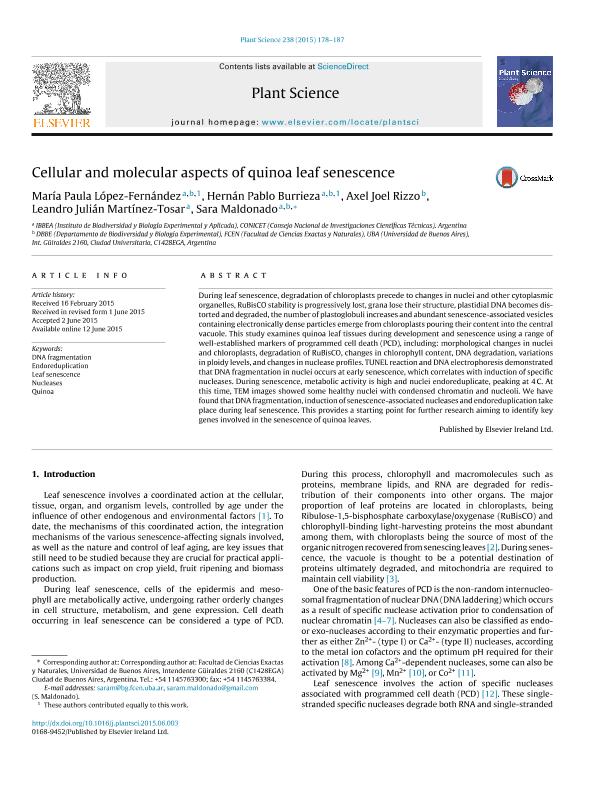Artículo
Cellular and molecular aspects of quinoa leaf senescence
Lopez Fernandez, Maria Paula ; Burrieza, Hernán Pablo; Rizzo, Axel Joel
; Burrieza, Hernán Pablo; Rizzo, Axel Joel ; Martínez Tosar, Leandro Julián
; Martínez Tosar, Leandro Julián ; Maldonado, Sara Beatriz
; Maldonado, Sara Beatriz
 ; Burrieza, Hernán Pablo; Rizzo, Axel Joel
; Burrieza, Hernán Pablo; Rizzo, Axel Joel ; Martínez Tosar, Leandro Julián
; Martínez Tosar, Leandro Julián ; Maldonado, Sara Beatriz
; Maldonado, Sara Beatriz
Fecha de publicación:
09/2015
Editorial:
Elsevier Ireland
Revista:
Plant Science
ISSN:
0168-9452
Idioma:
Inglés
Tipo de recurso:
Artículo publicado
Clasificación temática:
Resumen
During leaf senescence, degradation of chloroplasts precede to changes in nuclei and other cytoplasmic organelles, RuBisCO stability is progressively lost, grana lose their structure, plastidial DNA becomes distorted and degraded, the number of plastoglobuli increases and abundant senescence-associated vesicles containing electronically dense particles emerge from chloroplasts pouring their content into the central vacuole. This study examines quinoa leaf tissues during development and senescence using a range of well-established markers of programmed cell death (PCD), including: morphological changes in nuclei and chloroplasts, degradation of RuBisCO, changes in chlorophyll content, DNA degradation, variations in ploidy levels, and changes in nuclease profiles. TUNEL reaction and DNA electrophoresis demonstrated that DNA fragmentation in nuclei occurs at early senescence, which correlates with induction of specific nucleases. During senescence, metabolic activity is high and nuclei endoreduplicate, peaking at 4. C. At this time, TEM images showed some healthy nuclei with condensed chromatin and nucleoli. We have found that DNA fragmentation, induction of senescence-associated nucleases and endoreduplication take place during leaf senescence. This provides a starting point for further research aiming to identify key genes involved in the senescence of quinoa leaves.
Palabras clave:
Dna Fragmentation
,
Endoreduplication
,
Leaf Senescence
,
Nucleases
,
Quinoa
Archivos asociados
Licencia
Identificadores
Colecciones
Articulos(IBBEA)
Articulos de INSTITUTO DE BIODIVERSIDAD Y BIOLOGIA EXPERIMENTAL Y APLICADA
Articulos de INSTITUTO DE BIODIVERSIDAD Y BIOLOGIA EXPERIMENTAL Y APLICADA
Citación
Lopez Fernandez, Maria Paula; Burrieza, Hernán Pablo; Rizzo, Axel Joel; Martínez Tosar, Leandro Julián; Maldonado, Sara Beatriz; Cellular and molecular aspects of quinoa leaf senescence; Elsevier Ireland; Plant Science; 238; 9-2015; 178-187
Compartir
Altmétricas



